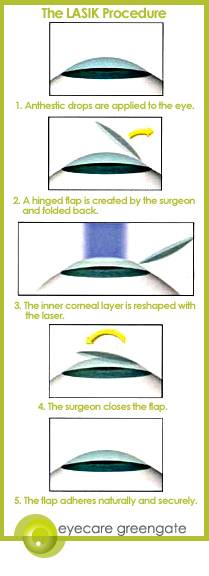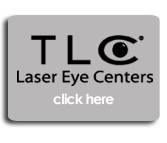LASIK (Laser-Assisted-In-Situ Keratomileusis) is currently one of the most frequently performed elective procedures in North America. It is a highly effective outpatient procedure that is suitable for most low, moderate and higher prescriptions. LASIK uses a cool beam of light from the excimer laser to gently reshape the front surface (cornea) of your eye.
The LASIK Procedure
Anesthetic drops are applied to the eye. A protective flap is created and gently lifted by the surgeon, revealing the inner corneal tissue. Computer-controlled pulses of cool laser light are applied to the inner layers of your cornea. As the laser pulses, it makes a ticking sound. The inner corneal layer is reshaped with the laser to mimic your contact lens or glasses prescription. The surgeon gently replaces the flap and aligns it to its original position. It heals naturally and securely. Some patients may feel slight irritation for a few hours, but most are quite comfortable after a nap and rest.
Custom LASIK - Greensburg
 While conventional LASIK has been a complete revolution in vision correction, TLC also offers the latest in laser vision correction technology: Custom LASIK. Custom LASIK is a procedure that enables your surgeon to further customize the conventional LASIK procedure to your individual eyes. This customized procedure may result in patients seeing clearer and sharper than ever before. FDA studies show that Custom LASIK may produce better vision than is possible with contact lenses or glasses.
While conventional LASIK has been a complete revolution in vision correction, TLC also offers the latest in laser vision correction technology: Custom LASIK. Custom LASIK is a procedure that enables your surgeon to further customize the conventional LASIK procedure to your individual eyes. This customized procedure may result in patients seeing clearer and sharper than ever before. FDA studies show that Custom LASIK may produce better vision than is possible with contact lenses or glasses.
In clinical studies, Custom LASIK has been able to provide patients with:
- A greater chance of having 20/20 vision
- The potential for better vision than is possible with contacts or glasses
- Less incidence of glare and halos
- Potentially better overall vision, even at night.
- Better Quality Vision
Clinical studies have shown that Custom LASIK may improve not only what you see but also how well you see it. In the past, all vision was measured using a standard vision chart. If you could see the letters, the doctor would use that measurement for how well you could see. But now, with Custom LASIK, doctors are able to focus on the quantity as well as the quality of your vision. Many patients who have had Custom LASIK are reporting the ability to see clearer than ever before. Several types of visual imperfections, referred to as lower- and higher-order aberrations, exist within the eye and may affect your vision (the amount of these aberrations vary from person to person). Previously, only lower-order aberrations (such as nearsightedness, farsightedness and astigmatism) could be measured and treated. Higher-order aberrations may also have a significant impact on vision and have been linked to glare and halos. Now Custom LASIK may help to further customize your treatment of these higher-order aberrations that, in the past, could not be adequately treated with glasses, contacts or conventional LASIK treatments. Your doctor will recommend the best procedure for you based on your personal aberrations.
Custom LASIK uses a wavefront analyzer to measure the way light travels through your eye. The wavefront analyzer creates a customized 3-D map of your eye that looks at your entire optical system. This map provides information about the unique visual characteristics of your eye which adds an additional level of data about your vision, enabling your TLC surgeon to further customize your vision correction.
Bladeless LASIK - Eyecare Greengate and TLC
 LASIK surgery may be elective, but good vision is not. We understand how valuable your sight is to you, and we keep our sights set on providing safe and advanced technologies for our patients. That is why Bladeless LASIK using the IntraLase® laser is a technology chosen for our Centers.
LASIK surgery may be elective, but good vision is not. We understand how valuable your sight is to you, and we keep our sights set on providing safe and advanced technologies for our patients. That is why Bladeless LASIK using the IntraLase® laser is a technology chosen for our Centers.
In the LASIK and CustomLASIK procedures, a flap of corneal tissue must be created and then folded back. The cornea is the transparent dome-like structure that covers the iris and pupil of your eye. By creating a flap in the cornea, the surgeon is able to perform the laser vision correction treatment on the inner layer of the cornea and allows for a rapid visual recovery. With Bladeless LASIK, the surgeon uses a laser to create the corneal flap. This technology enables the surgeon the ability to customize the corneal flap for every individual patient. In recent studies done by IntraLase, this technology may now make it possible to treat those who were previously dismissed as non candidates due to thin corneas.
Our doctors can offer customization for you in all parts of the procedure: custom diagnosis (before the procedure), custom flap (Bladeless LASIK), and custom treatment (to complete the procedure). Studies have shown the incidence of dry eye symptoms may be reduced with Bladeless LASIK. With Bladeless LASIK and its customization components, surgeons can treat a wider variety of patients, including patients with thin corneas. Bladeless LASIK has been used in more than one million LASIK procedures worldwide.
The eye doctors at Eyecare Greengate work very closely with the TLC surgeons to provide our patients with the best outcome.
Scleral Contact Lenses Improve Vision after LASIK
While LASIK surgery is usually very successful and the rate of complication is small, complications do sometimes arise. These complications can cause significant hardships for those affected.
The most common complications associated with LASIK are Dry Eye, Corneal thinning, and Night-time haloes.
These complications are not easily corrected via traditional treatments. At Eyecare Greengate we have found that scleral lenses are an effective way of treating these conditions.
We have had success with Scleral lenses treating all of these conditions.
Scleral lenses are designed to vault over the damaged or irregular surface of the eye and help to reduce the pain. They do this in two ways. First, the scleral lenses create a protective barrier over the dry eye surface protecting the cornea from the rubbing effect of the eyelids. There are more nerves per square inch of the cornea than in any other part of the body. Because the eyes blink several thousand times per day, protecting this surface drastically reduces the patient's pain and discomfort.

*closed the second Saturday of every month